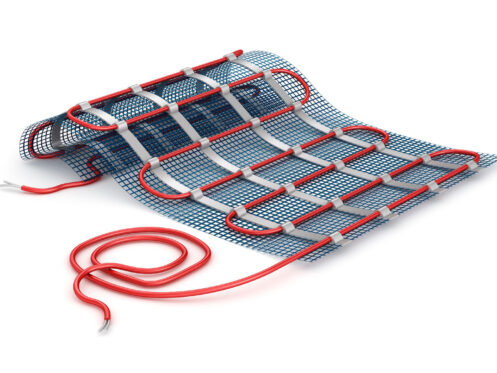Several options are available when choosing a heating system for your home. This article will explore radiant heating and help you decide if it’s the right choice for your needs.
What Is Radiant Heating?
Radiant heating is a method of heating that directly transfers warmth to objects and people in a room rather than heating the air first. It can be installed under floors, within walls, or in ceilings, depending on your home’s layout and your specific heating needs.
There are two primary types of radiant heating systems: electric and hydronic (water-based). Electric radiant systems use electric wires to generate heat, which a professional installs under floors. These systems are often more straightforward to install, making them a good option for retrofitting or smaller areas.
On the other hand, hydronic radiant heating relies on warm water flowing through tubes beneath the floor. Hydronic systems are more commonly installed in larger houses or for homes with existing boiler systems.
The core idea behind radiant heating is that heat is transferred directly to the surfaces and objects in the room, such as the floor, furniture, and people, through electric wires or water tubes. This setup allows for a more consistent and comfortable heating experience, as the warmth radiates evenly throughout the space. Indoor temperatures are controlled with a thermostat, just like with traditional systems.
Benefits of Radiant Heating
Radiant heating offers numerous advantages that can improve both comfort and efficiency in your home. From providing consistent warmth to reducing energy waste, it is an attractive alternative to traditional heating methods.
No More Cold Floors
One of the most frustrating aspects of the winter season is dealing with cold floors. Many homeowners resort to rugs or mats to help compensate for the chill that radiates from their flooring. With a radiant heating system, heat is generated from the floor and rises upward, ensuring warmth where it’s needed most. This type of heating not only works in harmony with the natural flow of heat but also guarantees warm floors when getting out of bed or after a shower.
No Airflow Contamination
One significant drawback of forced air heating systems is that they can circulate contaminants throughout your home. Because these systems rely on ductwork to push heated air into various rooms, they often stir up dust, pet dander, and other allergens, which can worsen symptoms for those with allergies, asthma, or other respiratory conditions. Many homeowners notice their symptoms becoming more pronounced indoors due to this circulation.
In contrast, radiant heating systems operate without the need for ducts or forced air. Because there’s no air movement, allergens and dust are not stirred up, providing a cleaner and more comfortable environment. This makes radiant floor heating particularly beneficial for households with family members who suffer from asthma or allergies, helping to prevent flare-ups while they are trying to relax at home.
No Air Duct Losses
One of the biggest advantages of radiant heating is that it doesn’t use ductwork to deliver heat to your home. The U.S. Department of Energy suggests the average homeowner loses 20% of their heating through leaks, gaps, and other faults in their forced air system. By choosing radiant heating, you can eliminate this energy waste and potentially lower your monthly heating costs. You will also avoid the expense of maintaining ductwork.
More Even and Comfortable Heat
Another significant advantage of radiant heating over other residential heating systems is that it provides more even and comfortable heat. Unlike forced air systems, which distribute heat from a single vent, radiant heating spreads warmth evenly across an entire room. Homeowners often find this method more comfortable, as it avoids the cold spots and sudden blasts of air common with forced air systems.
Energy-Efficient Heating
Radiant heating is highly energy-efficient because it eliminates heat loss through air circulation, a common issue with forced-air systems. With forced-air heating, warm air can escape through gaps and leaks around doors, windows, and even walls, reducing the overall efficiency. Radiant heating directly transfers heat to objects and people in the room, minimizing heat loss. This means you can maintain a comfortable temperature at a lower thermostat setting compared to forced-air systems, potentially reducing your energy consumption and heating costs.
Long Lifespan
Radiant floor heating has one of the longest lifespans available for home heating systems. Electric underfloor heating systems can last up to 25 years with minimal maintenance needs. Hydronic heated floors that use a boiler system can last up to 50 years or more with proper care and upkeep.
Ultra-Quiet Operation
One lesser-known advantage of radiant heating is its quiet operation. With no blower fan to produce noise, you won’t have to worry about the disruptive sounds typically associated with forced-air systems. Additionally, there are no annoying popping or creaking noises from expanding and contracting ductwork. When properly installed, a radiant heating system operates silently, ensuring a peaceful and comfortable home environment.
Cons of Radiant Heating
While radiant heating offers many advantages, it also has a few notable drawbacks. Homeowners should consider these challenges when deciding if radiant heating is the right choice for their home.
Expensive to Retrofit
Radiant floor heating is an excellent choice for new home builds, where floors and walls are easily accessible. However, retrofitting an existing home can be significantly more expensive. Installing radiant heating requires access to your flooring and possibly your walls or ceilings if you want to add radiant panels. This process typically involves extensive renovation, making it a costly option for homeowners looking to upgrade from a forced air system.
High Repair Costs
Another pitfall of radiant floor heating is that it’s all hidden beneath your floor and sometimes in your walls and ceilings. When you experience an issue with your system, your technician may have to remove some of your flooring in order to access the necessary components to repair it. This can be quite labor-intensive and costly to have done.
Limited Flooring Choices
In a perfect world, you would be able to choose whatever floor material and design you would like to have laid over your radiant heating system. However, it’s essential to realize that not all flooring materials are going to be able to conduct heat at the same efficiency level. Ideally, you want to choose a flooring material that is a great conductor of heat so that all of the heat your system produces can be transferred to the items and people in your home. Some of the best conductors include ceramic tiles and stone flooring. Hardwood isn’t always as effective, and carpeting can be very challenging.
Expert Radiant Heating Service
At F.F. Hitchcock Plumbing, Heating & Cooling, we are a family business that has been serving the residents of Cheshire, CT and the surrounding areas for years. We install, repair, and maintain heating and cooling systems and we can handle all your plumbing needs. If you are considering radiant heating for your home, contact us today to schedule an appointment with one of our experienced team members.








